Perkins Engine 854E-E34TA, 854F-E34T Service Manual
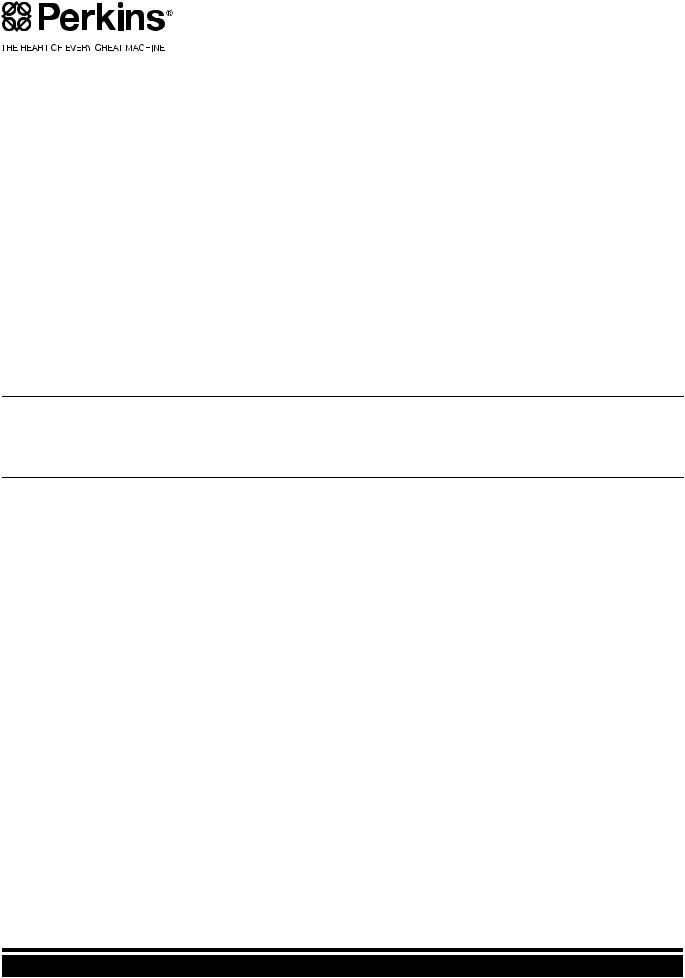
SEBU8726-02
July 2013
Operation and
Maintenance
Manual
854E-E34TA and 854F-E34T Industrial
Engines
JR (Engine)
JS (Engine)
JT (Engine)

Important Safety Information
Most accidents that involve product operation, maintenance and repair are caused by failure to observe basic safety rules or precautions. An accident can often be avoided by recognizing potentially hazardous situations before an accident occurs. A person must be alert to potential hazards. This person should also have the necessary training, skills and tools to perform these functions properly.
Improper operation, lubrication, maintenance or repair of this product can be dangerous and could result in injury or death.
Do not operate or perform any lubrication, maintenance or repair on this product, until you have read and understood the operation, lubrication, maintenance and repair information.
Safety precautions and warnings are provided in this manual and on the product. If these hazard warnings are not heeded, bodily injury or death could occur to you or to other persons.
The hazards are identified by the “Safety Alert Symbol” and followed by a “Signal Word” such as “DANGER”, “WARNING” or “CAUTION”. The Safety Alert “WARNING” label is shown below.
The meaning of this safety alert symbol is as follows:
Attention! Become Alert! Your Safety is Involved.
The message that appears under the warning explains the hazard and can be either written or pictorially presented.
Operations that may cause product damage are identified by “NOTICE” labels on the product and in this publication.
Perkins cannot anticipate every possible circumstance that might involve a potential hazard. The warnings in this publication and on the product are, therefore, not all inclusive. If a tool, procedure, work method or operating technique that is not specifically recommended by Perkins is used,
you must satisfy yourself that it is safe for you and for others. You should also ensure that the product will not be damaged or be made unsafe by the operation, lubrication, maintenance or repair procedures that you choose.
The information, specifications, and illustrations in this publication are on the basis of information that was available at the time that the publication was written. The specifications, torques, pressures, measurements, adjustments, illustrations, and other items can change at any time. These changes can affect the service that is given to the product. Obtain the complete and most current information before you start any job. Perkins dealers or Perkins distributors have the most current information available.
When replacement parts are required for this product Perkins recommends using Perkins replacement parts.
Failure to heed this warning can lead to premature failures, product damage, personal injury or death.

SEBU8726 |
3 |
Table of Contents
Table of Contents |
|
Foreword.............................. ............................. |
4 |
Safety Section |
|
Safety Messages....................... ....................... |
5 |
General Hazard Information............... .............. |
6 |
Burn Prevention........................ ........................ |
9 |
Fire Prevention and Explosion Prevention ... .. 10
Crushing Prevention and Cutting Prevention . 12
Mounting and Dismounting............... .............. |
12 |
High Pressure Fuel Lines ................ ............... |
12 |
Before Starting Engine ................. .................. |
14 |
Engine Starting........................ ....................... |
14 |
Engine Stopping ....................... ...................... |
14 |
Electrical System...................... ...................... |
14 |
Engine Electronics..................... ..................... |
16 |
Product Information Section |
|
General Information.................... .................... |
17 |
Product Identification Information.......... ......... |
25 |
Operation Section |
|
Lifting and Storage..................... ..................... |
30 |
Features and Controls.................. .................. |
32 |
Engine Diagnostics..................... .................... |
49 |
Engine Starting........................ ....................... |
53 |
Engine Operation...................... ...................... |
56 |
Cold Weather Operation................. ................ |
60 |
Engine Stopping ....................... ...................... |
64 |
Maintenance Section |
|
Refill Capacities....................... ....................... |
66 |
Maintenance Recommendations.......... .......... |
80 |
Maintenance Interval Schedule........... ........... |
83 |
Warranty Section |
|
Warranty Information.................. ................... |
112 |
Reference Information Section |
|
Reference Materials ................... ................... |
113 |
Index Section |
|
Index............................... ............................... |
114 |

4
Foreword
Foreword
Literature Information
This manual contains safety, operation instructions,
lubrication and maintenance information. This manual should be stored in or near the engine area in a
literature holder or literature storage area. Read, study and keep it with the literature and engine information.
English is the primary language for all Perkins publications. The English used facilitates translation and consistency.
Some photographs or illustrations in this manual show details or attachments that may be different from your engine. Guards and covers may have been removed for illustrative purposes. Continuing improvement and advancement of product design may have caused changes to your engine which are not included in this manual. Whenever a question arises regarding your engine, or this manual, please consult with your Perkins dealer or your Perkins distributor for the latest available information.
Safety
This safety section lists basic safety precautions. In addition, this section identifies hazardous, warning
situations. Read and understand the basic precautions listed in the safety section before
operating or performing lubrication, maintenance and repair on this product.
Operation
Operating techniques outlined in this manual are basic. They assist with developing the skills and techniques required to operate the engine more efficiently and economically. Skill and techniques develop as the operator gains knowledge of the engine and its capabilities.
The operation section is a reference for operators. Photographs and illustrations guide the operator through procedures of inspecting, starting, operating and stopping the engine. This section also includes a discussion of electronic diagnostic information.
Maintenance
The maintenance section is a guide to engine care. The illustrated, step-by-step instructions are grouped by service hours and/or calendar time maintenance
intervals. Items in the maintenance schedule are referenced to detailed instructions that follow.
SEBU8726
Recommended service should be performed at the appropriate intervals as indicated in the Maintenance Interval Schedule. The actual operating environment of the engine also governs the Maintenance Interval Schedule. Therefore, under extremely severe, dusty, wet or freezing cold operating conditions, more frequent lubrication and maintenance than is specified in the Maintenance Interval Schedule may be necessary.
The maintenance schedule items are organized for a preventive maintenance management program. If the preventive maintenance program is followed, a periodic tune-up is not required. The implementation of a preventive maintenance management program should minimize operating costs through cost avoidances resulting from reductions in unscheduled downtime and failures.
Maintenance Intervals
Perform maintenance on items at multiples of the original requirement. We recommend that the maintenance schedules be reproduced and displayed near the engine as a convenient reminder. We also
recommend that a maintenance record be maintained as part of the engine's permanent record.
Your authorized Perkins dealer or your Perkins distributor can assist you in adjusting your maintenance schedule to meet the needs of your operating environment.
Overhaul
Major engine overhaul details are not covered in the Operation and Maintenance Manual except for the
interval and the maintenance items in that interval. Major repairs should only be carried out by Perkins
authorized personnel. Your Perkins dealer or your Perkins distributor offers a variety of options regarding overhaul programs. If you experience a major engine failure, there are also numerous after failure overhaul options available. Consult with your Perkins dealer or your Perkins distributor for information regarding these options.
California Proposition 65 Warning
Diesel engine exhaust and some of its constituents
are known to the State of California to cause cancer, birth defects, and other reproductive harm. Battery
posts, terminals and related accessories contain lead and lead compounds. Wash hands after handling.
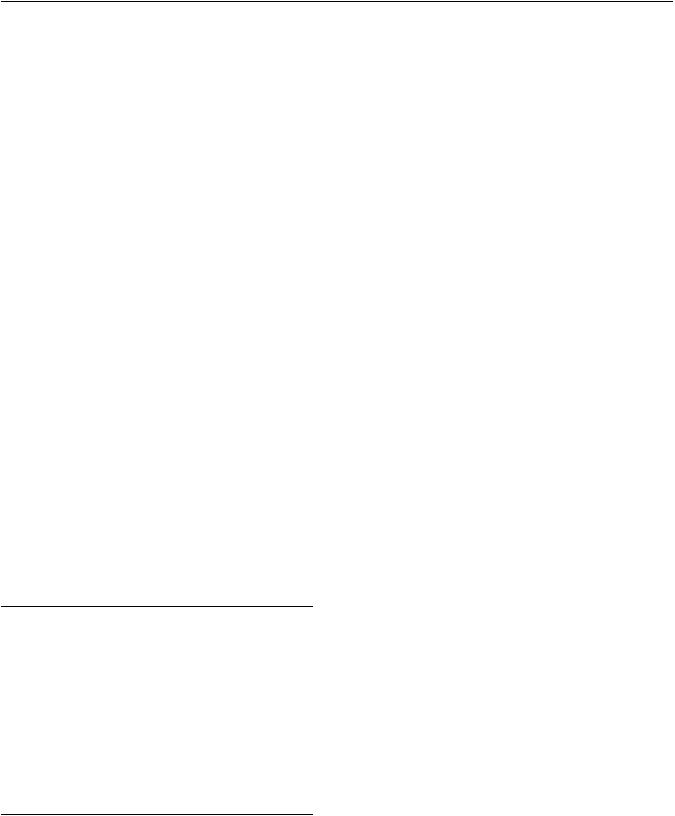
SEBU8726
Safety Section
i04112132
Safety Messages
There may be several specific warning signs on your engine. The exact location and a description of the warning signs are reviewed in this section. Please become familiar with all warning signs.
Ensure that all of the warning signs are legible. Clean the warning signs or replace the warning signs if the
words cannot be read or if the illustrations are not visible. Use a cloth, water, and soap to clean the
warning signs. Do not use solvents, gasoline, or other harsh chemicals. Solvents, gasoline, or harsh
chemicals could loosen the adhesive that secures the warning signs. The warning signs that are loosened
could drop off the engine.
Replace any warning sign that is damaged or missing. If a warning sign is attached to a part of the engine that is replaced, install a new warning sign on the replacement part. Your Perkins distributor can provide new warning signs.
Universal Warning
Do not operate or work on this equipment unless you have read and understand the instructions and warnings in the Operation and Maintenance Manuals. Failure to follow the instructions or heed the warnings could result in serious injury or death.
Illustration 1 |
g01154807 |
Typical example
The Universal Warning label (1) is located on the top
of the engine, on the engine interface connector cover.
5
Safety Section
Safety Messages
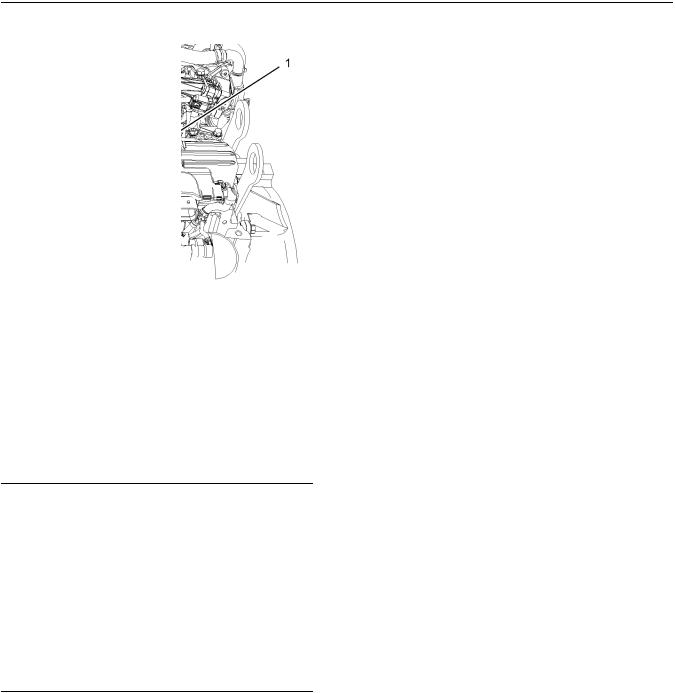
6 |
SEBU8726 |
Safety Section
General Hazard Information
Illustration 2
Typical example
i03566024
General Hazard Information
Illustration 3 |
g00104545 |
Attach a “Do Not Operate” warning tag or a similar warning tag to the start switch or to the controls before the engine is serviced or before the engine is repaired. Attach the warning tags to the engine and to each operator control station. When it is appropriate, disconnect the starting controls.
Do not allow unauthorized personnel on the engine, or around the engine when the engine is being serviced.
g02582556
•Tampering with the engine installation or tampering with the OEM supplied wiring can be dangerous. Personal injury, death and/or engine damage could result.
•Vent the engine exhaust to the outside when the engine is operated in an enclosed area.
•If the engine is not running, do not release the secondary brake or the parking brake systems unless the vehicle is blocked or unless the vehicle is restrained.
•Wear a hard hat, protective glasses, and other protective equipment, as required.
•When work is performed around an engine that is operating, wear protective devices for ears in order to help prevent damage to hearing.
•Do not wear loose clothing or jewelry that can snag on controls or on other parts of the engine.
•Ensure that all protective guards and all covers are secured in place on the engine.
•Never put maintenance fluids into glass containers. Glass containers can break.
•Use all cleaning solutions with care.
•Report all necessary repairs.
Unless other instructions are provided, perform the maintenance under the following conditions:
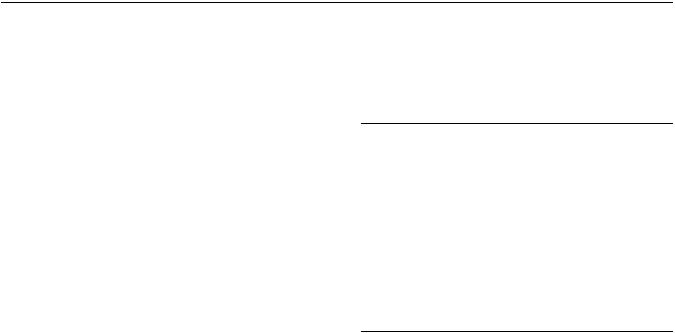
SEBU8726
•The engine is stopped. Ensure that the engine can not be started.
•The protective locks or the controls are in the applied position.
•Engage the secondary brakes or parking brakes.
•Block the vehicle or restrain the vehicle before maintenance or repairs are performed.
•Disconnect the batteries when maintenance is performed or when the electrical system is serviced. Disconnect the battery ground leads. Tape the leads in order to help prevent sparks.
•Disconnect the connector for the unit injector that is located on the valve cover base. This will help prevent personal injury from the high voltage to the unit injectors. Do not come in contact with the unit injector terminals while the engine is operating.
•Do not attempt any repairs or any adjustments to the engine while the engine is operating.
•Do not attempt any repairs that are not understood. Use the proper tools. Replace any equipment that is damaged or repair the equipment.
•For initial start-up of a new engine or for starting an engine that has been serviced, make provisions to stop the engine if an overspeed occurs. This may be accomplished by shutting off the fuel supply and/or the air supply to the engine.
•Start the engine from the operator's station (cab). Never short across the starting motor terminals or the batteries. This could bypass the engine neutral start system and/or the electrical system could be damaged.
Engine exhaust contains products of combustion which may be harmful to your health. Always start the engine and operate the engine in a well ventilated area. If the engine is in an enclosed area, vent the engine exhaust to the outside.
Cautiously remove the following parts. To help prevent spraying or splashing of pressurized fluids, hold a rag over the part that is being removed.
•Filler caps
•Grease fittings
•Pressure taps
•Breathers
•Drain plugs
7
Safety Section
General Hazard Information
Use caution when cover plates are removed. Gradually loosen, but do not remove the last two bolts or nuts that are located at opposite ends of the cover plate or the device. Before removing the last two bolts or nuts, pry the cover loose in order to relieve any spring pressure or other pressure.
Illustration 4 |
g00702020 |
•Wear a hard hat, protective glasses, and other protective equipment, as required.
•When work is performed around an engine that is operating, wear protective devices for ears in order to help prevent damage to hearing.
•Do not wear loose clothing or jewelry that can snag on controls or on other parts of the engine.
•Ensure that all protective guards and all covers are secured in place on the engine.
•Never put maintenance fluids into glass containers. Glass containers can break.
•Use all cleaning solutions with care.
•Report all necessary repairs.
Unless other instructions are provided, perform the maintenance under the following conditions:
•The engine is stopped. Ensure that the engine cannot be started.
•Disconnect the batteries when maintenance is performed or when the electrical system is serviced. Disconnect the battery ground leads. Tape the leads in order to help prevent sparks.
•Do not attempt any repairs that are not understood. Use the proper tools. Replace any equipment that is damaged or repair the equipment.
Pressurized Air and Water
Pressurized air and/or water can cause debris and/or hot water to be blown out. This could result in personal injury.
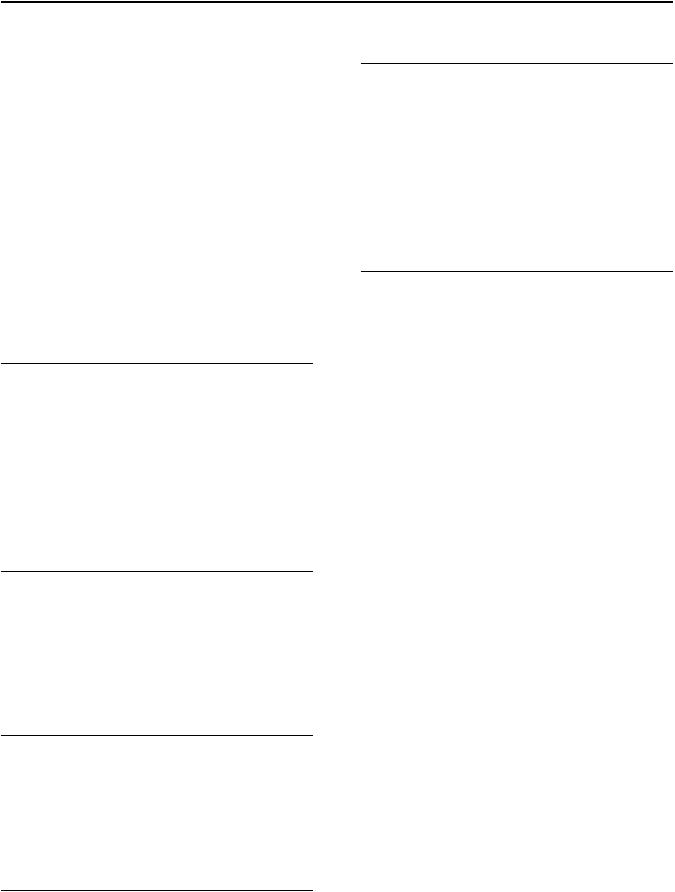
8
Safety Section
General Hazard Information
When pressurized air and/or pressurized water is used for cleaning, wear protective clothing, protective shoes, and eye protection. Eye protection includes goggles or a protective face shield.
The maximum air pressure for cleaning purposes must be below 205 kPa (30 psi). The maximum water pressure for cleaning purposes must be below
275 kPa (40 psi).
Fluid Penetration
Pressure can be trapped in the hydraulic circuit long after the engine has been stopped. The pressure can cause hydraulic fluid or items such as pipe plugs to escape rapidly if the pressure is not relieved correctly.
Do not remove any hydraulic components or parts until pressure has been relieved or personal injury may occur. Do not disassemble any hydraulic components or parts until pressure has been relieved or personal injury may occur. Refer to the OEM information for any procedures that are required to relieve the hydraulic pressure.
Illustration 5 |
g00687600 |
Always use a board or cardboard when you check for a leak. Leaking fluid that is under pressure can penetrate body tissue. Fluid penetration can cause serious injury and possible death. A pin hole leak can cause severe injury. If fluid is injected into your skin, you must get treatment immediately. Seek treatment from a doctor that is familiar with this type of injury.
Containing Fluid Spillage
NOTICE
Care must be taken to ensure that fluids are contained during performance of inspection, maintenance, testing, adjusting and repair of the product. Be prepared to collect the fluid with suitable containers before opening any compartment or disassembling any component containing fluids.
Dispose of all fluids according to local regulations and mandates.
SEBU8726
Asbestos Information
Illustration 6 |
g00702022 |
Perkins |
replacement parts that are shipped from |
Perkins |
are asbestos free. Perkins recommends |
the use of only genuine Perkins replacement parts. Use the following guidelines when you handle any replacement parts that contain asbestos or when you handle asbestos debris.
Use caution. Avoid inhaling dust that might be generated when you handle components that contain asbestos fibers. Inhaling this dust can be hazardous to your health. The components that may contain asbestos fibers are brake pads, brake bands, lining material, clutch plates, and some gaskets. The asbestos that is used in these components is usually bound in a resin or sealed in some way. Normal handling is not hazardous unless airborne dust that contains asbestos is generated.
If dust that may contain asbestos is present, there are several guidelines that should be followed:

SEBU8726
•Never use compressed air for cleaning.
•Avoid brushing materials that contain asbestos.
•Avoid grinding materials that contain asbestos.
•Use a wet method in order to clean up asbestos materials.
•A vacuum cleaner that is equipped with a high efficiency particulate air filter (HEPA) can also be used.
•Use exhaust ventilation on permanent machining jobs.
•Wear an approved respirator if there is no other way to control the dust.
•Comply with applicable rules and regulations for the work place. In the United States , use Occupational Safety and Health Administration (OSHA) requirements. These OSHA requirements can be found in 29 CFR 1910.1001.
•Obey environmental regulations for the disposal of asbestos.
•Stay away from areas that might have asbestos particles in the air.
Dispose of Waste Properly
Illustration 7 |
g00706404 |
Improperly disposing of waste can threaten the environment. Potentially harmful fluids should be disposed of according to local regulations.
Always use leakproof containers when you drain fluids. Do not pour waste onto the ground, down a drain, or into any source of water.
9
Safety Section
Burn Prevention
i04289958
Burn Prevention
Do not touch any part of an operating engine system. The engine, the exhaust, and the engine aftertreatment system can reach temperatures as high as 650 °C (1202 °F) under normal operating conditions.
At idle engine speed and/or zero vehicle speed, an operator can request a manual regeneration. Under this condition, the exhaust gas temperature can reach 650 °C (1202 °F). Otherwise automatic regeneration can produce exhaust gas temperatures as high as 650 °C (1202 °F).
Allow the engine system to cool before any maintenance is performed. Relieve all pressure in the following systems, hydraulic system, lubrication system, fuel system, and the cooling system before related items are disconnected.
Contact with high pressure fuel may cause fluid penetration and burn hazards. High pressure fuel spray may cause a fire hazard. Failure to follow these inspection, maintenance and service instructions may cause personal injury or death.
After the engine has stopped, you must wait for 10 minutes in order to allow the fuel pressure to be purged from the high-pressure fuel lines before any service or repair is performed on the engine fuel lines.
Induction System
Sulfuric Acid Burn Hazard may cause serious personal injury or death.
The exhaust gas cooler may contain a small
amount of sulfuric acid. The use of fuel with sulfur levels greater than 15 ppm may increase the
amount of sulfuric acid formed. The sulfuric acid may spill from the cooler during service of the en-
gine. The sulfuric acid will burn the eyes, skin and clothing on contact. Always wear the appropriate personal protective equipment (PPE) that is noted on a material safety data sheet (MSDS) for sulfuric acid. Always follow the directions for first aid that are noted on a material safety data sheet (MSDS) for sulfuric acid.
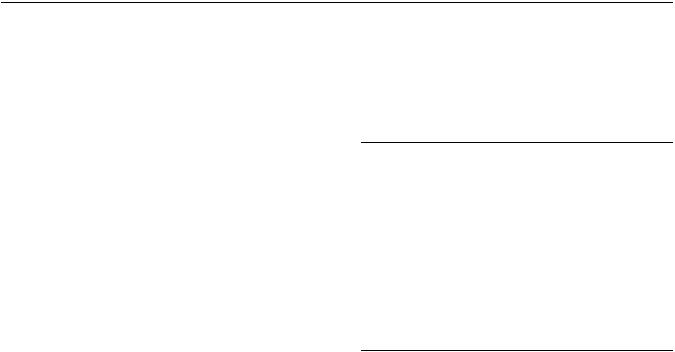
10
Safety Section
Fire Prevention and Explosion Prevention
Coolant
When the engine is at operating temperature, the engine coolant is hot. The coolant is also under pressure. The radiator and all lines to the heaters or to the engine contain hot coolant.
Any contact with hot coolant or with steam can cause severe burns. Allow cooling system components to cool before the cooling system is drained.
Check the coolant level after the engine has stopped and the engine has been allowed to cool.
Ensure that the filler cap is cool before removing the filler cap. The filler cap must be cool enough to touch with a bare hand. Remove the filler cap slowly in order to relieve pressure.
Cooling system conditioner contains alkali. Alkali can cause personal injury. Do not allow alkali to contact the skin, the eyes, or the mouth.
Oils
Hot oil and hot lubricating components can cause personal injury. Do not allow hot oil to contact the skin. Also, do not allow hot components to contact the skin.
Batteries
Electrolyte is an acid. Electrolyte can cause personal injury. Do not allow electrolyte to contact the skin or the eyes. Always wear protective glasses for servicing batteries. Wash hands after touching the batteries and connectors. Use of gloves is recommended.
SEBU8726
i04303237
Fire Prevention and Explosion
Prevention
Illustration 8 |
g00704000 |
All fuels, most lubricants, and some coolant mixtures are flammable.
Flammable fluids that are leaking or spilled onto hot surfaces or onto electrical components can cause a fire. Fire may cause personal injury and property damage.
After the emergency stop button is operated, ensure that you allow 15 minutes, before the engine covers are removed.
Determine whether the engine will be operated in an environment that allows combustible gases to be drawn into the air inlet system. These gases could cause the engine to overspeed. Personal injury, property damage, or engine damage could result.
If the application involves the presence of combustible gases, consult your Perkins dealer and/ or your Perkins distributor for additional information about suitable protection devices.
Remove all flammable combustible materials or conductive materials such as fuel, oil, and debris from the engine. Do not allow any flammable combustible
materials or conductive materials to accumulate on the engine.
Store fuels and lubricants in correctly marked containers away from unauthorized persons. Store oily rags and any flammable materials in protective
containers. Do not smoke in areas that are used for storing flammable materials.
Do not expose the engine to any flame.
Exhaust shields (if equipped) protect hot exhaust components from oil or fuel spray in a line, a tube, or
a seal failure. Exhaust shields must be installed correctly.

SEBU8726 |
11 |
Safety Section
Fire Prevention and Explosion Prevention
Do not weld on lines or tanks that contain flammable fluids. Do not flame cut lines or tanks that contain flammable fluid. Clean any such lines or tanks
thoroughly with a nonflammable solvent prior to welding or flame cutting.
Wiring must be kept in good condition. All electrical wires must be correctly routed and securely attached. Check all electrical wires daily. Repair any wires that are loose or frayed before you operate the engine. Clean all electrical connections and tighten all electrical connections.
Eliminate all wiring that is unattached or unnecessary. Do not use any wires or cables that are smaller than the recommended gauge. Do not bypass any fuses and/or circuit breakers.
Arcing or sparking could cause a fire. Secure connections, recommended wiring, and correctly maintained battery cables will help to prevent arcing or sparking.
Contact with high pressure fuel may cause fluid penetration and burn hazards. High pressure fuel spray may cause a fire hazard. Failure to follow these inspection, maintenance and service instructions may cause personal injury or death.
After the engine has stopped, you must wait for 10 minutes in order to allow the fuel pressure to be purged from the high-pressure fuel lines before any service or repair is performed on the engine fuel lines.
Ensure that the engine is stopped. Inspect all lines
and hoses for wear or for deterioration. The hoses must be correctly routed. The lines and hoses must
have adequate support and secure clamps.
Ensure that Oil filters and fuel filters are correctly installed. The filter housings must be tightened to the correct torque. Refer to the Disassembly and Assembly manual for more information.
Illustration 9 |
g00704059 |
Use caution when you are refueling an engine. Do not smoke while you are refueling an engine. Do not refuel an engine near open flames or sparks. Always stop the engine before refueling.
Illustration 10 |
g00704135 |
Gases from a battery can explode. Keep any open flames or sparks away from the top of a battery. Do not smoke in battery charging areas.
Never check the battery charge by placing a metal object across the terminal posts. Use a voltmeter or a hydrometer.
Incorrect jumper cable connections can cause an explosion that can result in injury. Refer to the Operation Section of this manual for specific instructions.

12 |
SEBU8726 |
Safety Section
Crushing Prevention and Cutting Prevention
Do not charge a frozen battery. Charging a frozen battery may cause an explosion.
The batteries must be kept clean. The covers (if equipped) must be kept on the cells. Use the recommended cables, connections, and battery box covers when the engine is operated.
Fire Extinguisher
Make sure that a fire extinguisher is available. Be familiar with the operation of the fire extinguisher. Inspect the fire extinguisher and service the fire extinguisher regularly. Obey the recommendations on the instruction plate.
Lines, Tubes, and Hoses
Do not bend high-pressure lines. Do not strike highpressure lines. Do not install any lines that are damaged.
Leaks can cause fires. Consult your Perkins dealer or your Perkins distributor for replacement parts.
Replace the parts if any of the following conditions are present:
•High-pressure fuel line or lines are removed.
•End fittings are damaged or leaking.
•Outer coverings are chafed or cut.
•Wires are exposed.
•Outer coverings are ballooning.
•Flexible parts of the hoses are kinked.
•Outer covers have embedded armoring.
•End fittings are displaced.
Make sure that all clamps, guards, and heat shields are installed correctly. During engine operation, this check will help to prevent vibration, rubbing against other parts, and excessive heat.
Regeneration
The exhaust gas temperature during regeneration will be elevated. Follow proper fire prevention instructions and use the disable switch function when appropriate.
i02143194
Crushing Prevention and
Cutting Prevention
Unless other maintenance instructions are provided, never attempt adjustments while the engine is running.
Stay clear of all rotating parts and of all moving parts. Leave the guards in place until maintenance is performed. After the maintenance is performed, reinstall the guards.
Keep objects away from moving fan blades. The fan blades will throw objects or cut objects.
When objects are struck, wear protective glasses in order to avoid injury to the eyes.
Chips or other debris may fly off objects when objects are struck. Before objects are struck, ensure that no one will be injured by flying debris.
i04016709
Mounting and Dismounting
Do not climb on the engine or the engine aftertreatment. The engine and aftertreatment have not been designed with mounting or dismounting locations.
Refer to the OEM for the location of foot and hand holds for your specific application.
i04112191
High Pressure Fuel Lines
Contact with high pressure fuel may cause fluid penetration and burn hazards. High pressure fuel spray may cause a fire hazard. Failure to follow these inspection, maintenance and service instructions may cause personal injury or death.
Support the component correctly when work beneath the component is performed.

SEBU8726 |
13 |
Safety Section
High Pressure Fuel Lines
Illustration 11 |
|
(1) High-pressure line |
(3) High-pressure line |
(2) High-pressure line |
(4) High-pressure line |
The high-pressure fuel lines are the fuel lines that are between the high-pressure fuel pump and the highpressure fuel manifold and the fuel lines that are between the fuel manifold and cylinder head. These
fuel lines are different from fuel lines on other fuel systems.
These differences are because of the following items:
•The high-pressure fuel lines are constantly charged with high pressure.
•The internal pressures of the high-pressure fuel lines are higher than other types of fuel system.
•The high-pressure fuel lines are formed to shape and then strengthened by a special process.
Do not step on the high-pressure fuel lines. Do not deflect the high-pressure fuel lines. Do not bend or strike the high-pressure fuel lines. Deformation or damage of the high-pressure fuel lines may cause a point of weakness and potential failure.
Do not check the high-pressure fuel lines with the engine or the starting motor in operation. After the engine has stopped wait for 10 minutes in order to allow the fuel pressure to be purged from the highpressure fuel lines before any service or repair is performed.
Do not loosen the high-pressure fuel lines in order to remove air from the fuel system. This procedure is not required.
Visually inspect the high-pressure fuel lines before the engine is started. This inspection should be each day.
g02315653
(5)High-pressure fuel manifold (rail)
(6)Fuel transfer line that is high pressure
If you inspect the engine in operation, always use the proper inspection procedure in order to avoid a fluid penetration hazard. Refer to Operation and Maintenance Manual, “General hazard Information”.
•Inspect the high-pressure fuel lines for damage, deformation, a nick, a cut, a crease, or a dent.
•Do not operate the engine with a fuel leak. If there is a leak, do not tighten the connection in order to stop the leak. The connection must only be tightened to the recommended torque. Refer to Disassembly and Assembly, “Fuel injection lines - Remove and Fuel injection lines - Install”.
•If the high-pressure fuel lines are torqued correctly, and the high-pressure fuel lines are leaking the high-pressure fuel lines must be replaced.
•Ensure that all clips on the high-pressure fuel lines are in place. Do not operate the engine with clips that are damaged, missing, or loose.
•Do not attach any other item to the high-pressure fuel lines.
•Loosened high-pressure fuel lines must be replaced. Also removed high-pressure fuel lines must be replaced. Refer to Disassembly and Assembly, “Fuel Injection Lines - Install”.

14
Safety Section
Before Starting Engine
i02813489
Before Starting Engine
Before the initial start-up of an engine that is new, serviced or repaired, make provision to shut the engine off, in order to stop an overspeed. This may be accomplished by shutting off the air and/or fuel supply to the engine.
Overspeed shutdown should occur automatically for engines that are controlled electronically. If automatic shutdown does not occur, press the emergency stop button in order to cut the fuel and/or air to the engine.
Inspect the engine for potential hazards.
Before starting the engine, ensure that no one is on, underneath, or close to the engine. Ensure that the area is free of personnel.
If equipped, ensure that the lighting system for the engine is suitable for the conditions. Ensure that all lights work correctly, if equipped.
All protective guards and all protective covers must be installed if the engine must be started in order to perform service procedures. To help prevent an accident that is caused by parts in rotation, work around the parts carefully.
Do not bypass the automatic shutoff circuits. Do not
disable the automatic shutoff circuits. The circuits are provided in order to help prevent personal injury. The
circuits are also provided in order to help prevent engine damage.
See the Service Manual for repairs and for adjustments.
i04478934
Engine Starting
Do not use aerosol types of starting aids such as ether. Such use could result in an explosion and personal injury.
If a warning tag is attached to the engine start switch, or to the controls DO NOTstart the engine or move the controls. Consult with the person that attached the warning tag before the engine is started.
All protective guards and all protective covers must be installed if the engine must be started in order to perform service procedures. To help prevent an accident that is caused by parts in rotation, work around the parts carefully.
SEBU8726
Start the engine from the operators compartment or from the engine start switch.
Always start the engine according to the procedure that is described in the Operation and Maintenance Manual, “Engine Starting” topic in the Operation Section. Knowing that the correct procedure will help to prevent major damage to the engine components. Knowing that the procedure will also help to prevent personal injury.
To ensure that the jacket water heater (if equipped) and/or the lube oil heater (if equipped) is working correctly, check the water temperature gauge. Also, check the oil temperature gauge during the heater operation.
Engine exhaust contains products of combustion which can be harmful to your health. Always start the engine and operate the engine in a well ventilated area. If the engine is started in an enclosed area, vent the engine exhaust to the outside.
Note: These engines are equipped with a glow plug starting aid in each cylinder that heats the intake air in order to improve starting.
i02234873
Engine Stopping
Stop the engine according to the procedure in the Operation and Maintenance Manual, “Engine Stopping (Operation Section)” in order to avoid overheating of the engine and accelerated wear of the engine components.
Use the Emergency Stop Button (if equipped) ONLY in an emergency situation. Do not use the Emergency Stop Button for normal engine stopping. After an emergency stop, DO NOTstart the engine until the problem that caused the emergency stop has been corrected.
Stop the engine if an overspeed condition occurs during the initial start-up of a new engine or an engine that has been overhauled.
To stop an electronically controlled engine, cut the power to the engine and/or shutting off the air supply to the engine.
i04112409
Electrical System
Never disconnect any charging unit circuit or battery circuit cable from the battery when the charging unit is operating. A spark can cause the combustible gases that are produced by some batteries to ignite.
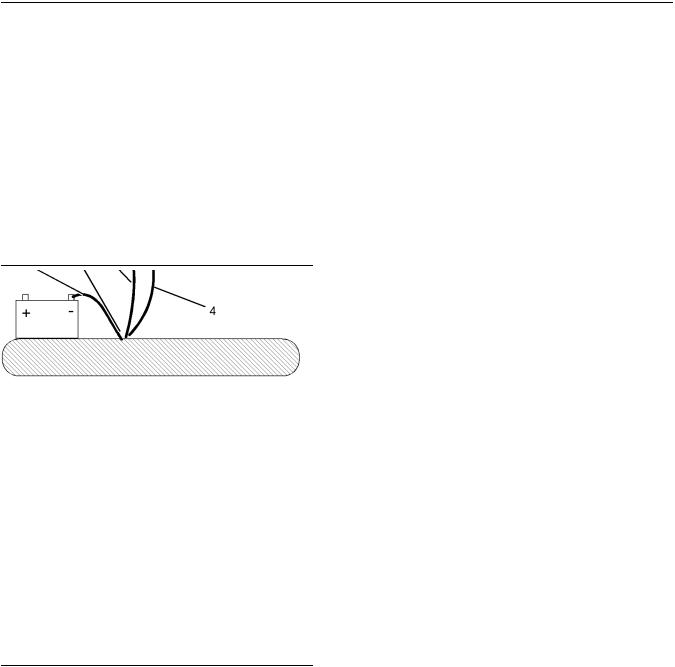
SEBU8726 |
15 |
Safety Section
Electrical System
To help prevent sparks from igniting combustible gases that are produced by some batteries, the negative “−” cable should be connected last from the external power source to the negative “−” terminal of the starting motor. If the starting motor is not equipped with a negative “−” terminal, connect the cable to the engine block.
Check the electrical wires daily for wires that are loose or frayed. Tighten all loose electrical connections before the engine is started. Repair all frayed electrical wires before the engine is started. See the Operation and Maintenance Manual for specific starting instructions.
Grounding Practices
|
|
Illustration 13 |
g02315900 |
|
|
Typical example |
|
|
|
(5) Ground to battery |
|
|
|
(6) Ground to engine block |
|
|
|
(7) Primary position for grounding |
|
|
|
Correct grounding for the engine electrical system is |
|
|
|
necessary for optimum engine performance and |
|
|
|
reliability. Incorrect grounding will result in |
|
|
|
uncontrolled electrical circuit paths and in unreliable |
|
|
|
electrical circuit paths. |
|
|
|
Uncontrolled electrical circuit paths can result in |
|
|
|
damage to engine components. |
|
|
|
Engines that are installed without engine-to-frame |
|
|
|
ground straps can be damaged by electrical |
|
Illustration 12 |
g02315896 |
discharge. |
|
Typical example |
|
To ensure the engine and the engine electrical |
|
(1) Ground to battery |
|
||
|
systems function correctly, an engine-to-frame |
||
(2) Primary position for grounding |
|
||
|
ground strap with a direct path to the battery must be |
||
(3) Ground to engine block |
|
||
(4) Ground to starting motor |
|
used. This path may be provided by way of a direct |
|
|
|
engine ground to the frame. |
|
|
|
The connections for the grounds should be tight and |
|
|
|
free of corrosion. The engine alternator must be |
|
|
|
grounded to the negative “-” |
battery terminal with a |
|
|
wire adequate to handle the full charging current of |
|
|
|
the alternator. |
|
The power supply connections and the ground connections for the engine electronics should always be from the isolator to the battery.
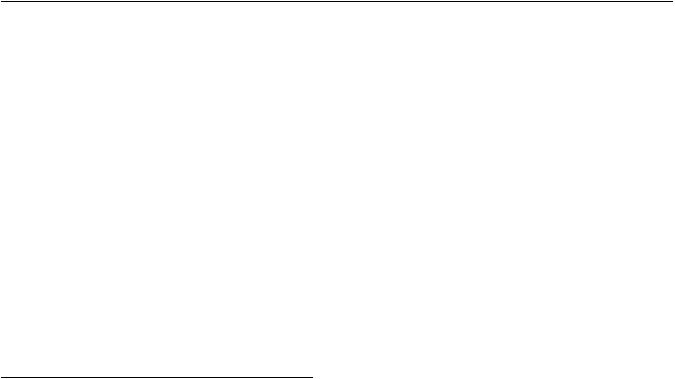
16
Safety Section
Engine Electronics
i04346349
Engine Electronics
Tampering with the electronic system installation or the OEM wiring installation can be dangerous and could result in personal injury or death and/or engine damage.
Electrical Shock Hazard. The electronic unit injectors use DC voltage. The ECM sends this voltage to the electronic unit injectors. Do not come in contact with the harness connector for the electronic unit injectors while the engine is operating. Failure to follow this instruction could result in personal injury or death.
This engine has a comprehensive, programmable Engine Monitoring System. The Electronic Control Module (ECM) has the ability to monitor the engine operating conditions. If any of the engine parameters extend outside an allowable range, the ECM will initiate an immediate action.
The following actions are available for engine monitoring control:
•Warning
•Derate
•Shutdown
The following monitored engine operating conditions and components have the ability to limit engine speed and/or the engine power :
•Engine Coolant Temperature
•Engine Oil Pressure
•Engine Speed
•Intake Manifold Air Temperature
•Engine Intake Throttle Valve Fault
•Wastegate Regulator
•Supply Voltage to Sensors
•Fuel Pressure in Manifold (Rail)
•NOxReduction System
•Engine Aftertreatment System
SEBU8726
The Engine Monitoring package can vary for different engine models and different engine applications. However, the monitoring system and the engine monitoring control will be similar for all engines.
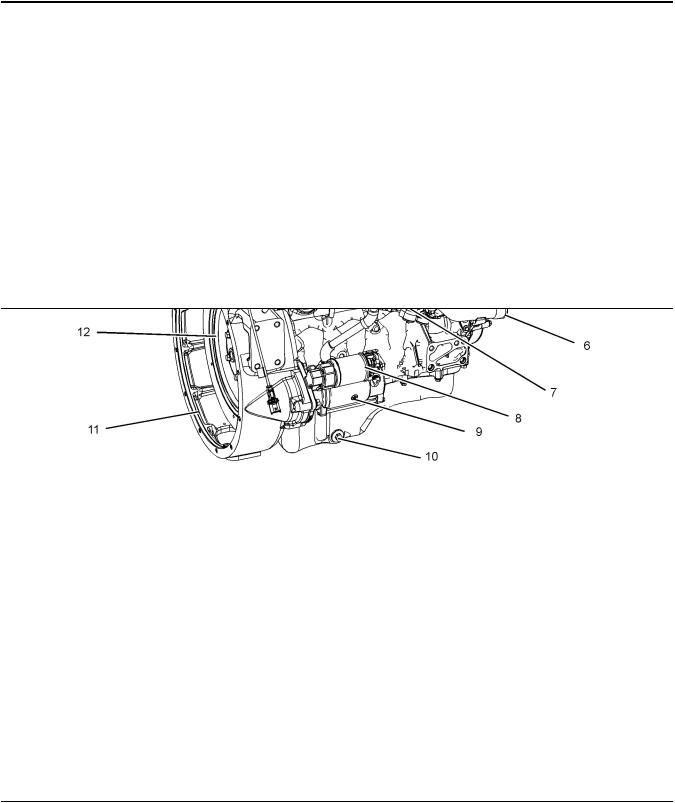
SEBU8726 |
17 |
Product Information Section
Model View Illustrations
Product Information
Section
General Information
i05297867
Model View Illustrations
The following model views show typical features of the engine. Due to individual applications, your engine may appear different from the illustrations.
Engine and Aftertreatment
Illustration 14 |
|
g03367500 |
Typical example |
|
|
(1) Engine aftertreatment system |
(5) Air intake from air filter |
(9) Starting motor |
(2) NOx control valve |
(6) Coolant intake connection |
(10) Oil drain plug |
(3) Air outlet connection from turbocharger |
(7) Turbocharger |
(11) Flywheel housing |
(4) Alternator |
(8) Solenoid for stating motor |
(12) Flywheel |

18 |
SEBU8726 |
General Information
Model View Illustrations
Illustration 15 |
|
g03367502 |
Typical example |
|
|
(13) Secondary fuel filter |
(15) Oil level gauge (Dipstick) |
(17) Valve mechanism cover |
(14) Oil filter |
(16) High-pressure fuel pump |
|

SEBU8726 |
19 |
General Information
Model View Illustrations
Illustration 16 |
|
|
g03367547 |
(18) Rear lifting eyes |
(21) |
Oil filler cap |
(24) Coolant outlet connection |
(19) Front lifting eye |
(22) |
Belt |
(25) Air inlet connection |
(20) Crankcase breather |
(23) Coolant pump |
|
|
The oil filler cap (21) can be located on the valve mechanism cover.
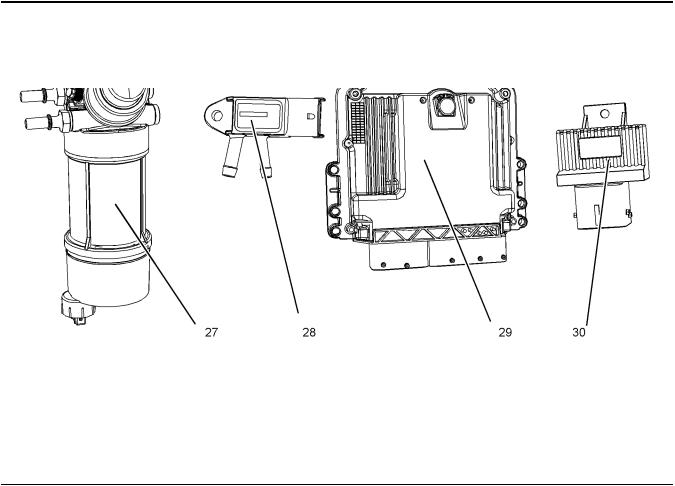
20 |
SEBU8726 |
General Information
Model View Illustrations
Off Engine Parts
Illustration 17 |
|
g03367521 |
(26) Fuel priming pump |
(28) Differential pressure sensor |
(30) Relay for glow plugs |
(27) Primary fuel filter |
(29) Electronic control module |
|

SEBU8726 |
21 |
General Information
Model View Illustrations
Engine View with Wall Flow Diesel Particulate Filter
Illustration 18 |
g03367096 |
Typical example
The wall flow Diesel Particulate Filter (DPF) will require a service, refer to this Operation and
Maintenance Manual, “Maintenance Interval Schedule” for the service period.
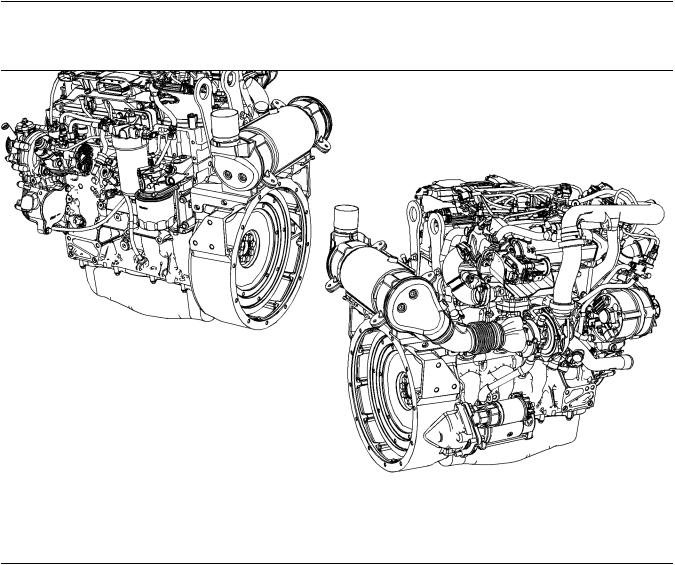
22 |
SEBU8726 |
General Information
Product Description
Engine View with Through Flow Diesel Particulate Filter
Illustration 19
Typical example
The through-flow type of DPF will not require a service interval.
i05326347
Product Description
The Perkins 854F-E34Tand the 854E-E34TA industrial engines has the following characteristics.
g03367094
•In-line 4 cylinder
•Two valves in each cylinder
•Four stroke cycle
•Turbocharged
•Turbocharged charge cooled
•Wall Flow Diesel Particulate Filter or Through-Flow Diesel Particulate Filter
Engine Specifications
Note: The front end of the engine is opposite the flywheel end of the engine. The left and the right sides of the engine are determined from the flywheel end. The number 1 cylinder is the front cylinder.
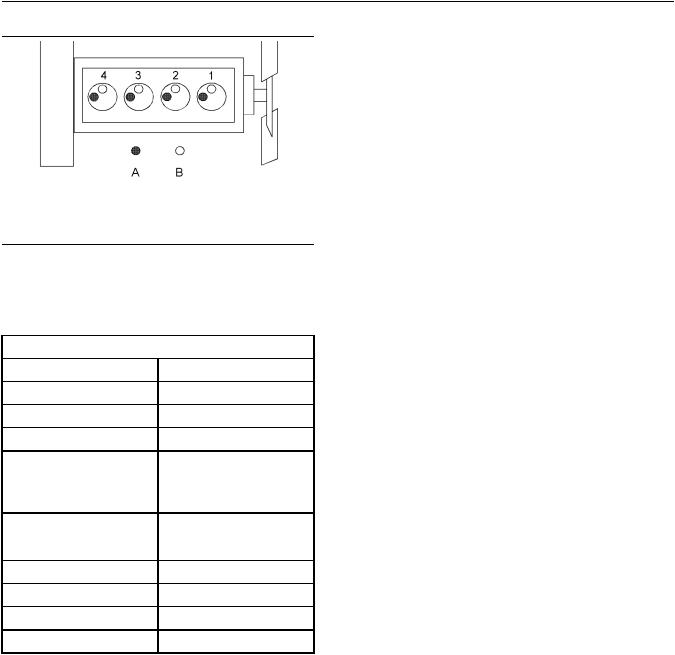
SEBU8726
Illustration 20 |
g02317934 |
Cylinder and valve location
(A)Exhaust valves
(B)Inlet valves
Table 1
854F-E34T and 854E-E34TA Engine Specifications
Operating Range (rpm) |
800 to 2500(1) |
Number of Cylinders |
4 In-Line |
Bore |
99 mm (3.89763 inch) |
Stroke |
110 mm (4.33070 inch) |
Power |
854F 45 to 55.4 kW |
|
(60.345 to 74.3 hp) |
|
854E 62 to 86 kW |
|
(83.142 to 115.326 hp) |
Aspiration
Compression Ratio
Displacement
Firing Order
Rotation (flywheel end)
854F Turbocharged
854E Turbocharged charge cooled
17:1
3.4L (207.48 cubic inch)
1-3-4-2
Counterclockwise
(1)The operating rpm is dependent on the engine rating, the application, and the configuration of the throttle.
Engine Type and Aftertreatment Type
There are three different engine types and two different types of aftertreatment. The 854E-E34TA is turbocharged, charge cooled engine, with a wall flow Diesel Particulate Filter (DPF). The letters JR will be on the identification plate.
The 854F-E34T is divided into two different engine types. The engine with JS on the identification plate will have a wall flow DPF. The engine with the letters JTon the identification plate will have a through-flow DPF.
The through-flow DPF will not require a service period.
23
General Information
Product Description
Electronic Engine Features
The engine operating conditions are monitored. The Electronic Control Module (ECM) controls the response of the engine to these conditions and to the demands of the operator. These conditions and operator demands determine the precise control of fuel injection by the ECM. The electronic engine control system provides the following features:
•Engine monitoring
•Engine speed governing
•Control of the injection pressure
•Cold start strategy
•Automatic air/fuel ratio control
•Torque rise shaping
•Injection timing control
•System diagnostics
•Aftertreatment Regeneration
For more information on electronic engine features, refer to the Operation and Maintenance Manual, “Features and Controls” topic (Operation Section).
Engine Diagnostics
The engine has built-in diagnostics in order to ensure that the engine systems are functioning correctly. The operator will be alerted to the condition by a “Stop or Warning” lamp. Under certain conditions, the engine horsepower and the vehicle speed may be limited.
The electronic service tool may be used to display the diagnostic codes.
There are three types of diagnostic codes: active, logged and event.
Most of the diagnostic codes are logged and stored in
the ECM. For additional information, refer to the Operation and Maintenance Manual, “Engine
Diagnostics” topic (Operation Section).
The ECM provides an electronic governor that controls the injector output in order to maintain the desired engine rpm.
Engine Cooling and Lubrication
The cooling system and lubrication system consists of the following components:

24 |
SEBU8726 |
General Information
Product Description
•Belt driven centrifugal water pump
•Water temperature regulator which regulates the engine coolant temperature
•Gear-driven rotor type oil pump
•Multi plate oil cooler
The engine lubricating oil is cooled and the engine lubricating oil is filtered.
Engine Service Life
Engine efficiency and maximum utilization of engine performance depend on the adherence to proper operation and maintenance recommendations. In
addition, use recommended fuels, coolants, and lubricants. Use the Operation and Maintenance
Manual as a guide for required engine maintenance.
Aftermarket Products and Perkins
Engines
Perkins does not warrant the quality or performance of non-Perkins fluids and filters.
When auxiliary devices, accessories, or consumables (filters, additives, catalysts,) which are made by other manufacturers are used on Perkins products, the Perkins warranty is not affected simply because of such use.
However, failures that result from the installation or use of other manufacturers devices, accessories, or consumables are NOT Perkins defects. Therefore, the defects are NOT covered under the Perkins warranty.
Aftertreatment System
The aftertreatment system is approved for use by Perkins . In order to be emission-compliant only the approved Perkins aftertreatment system must be used on a Perkins engine.

SEBU8726
Product Identification
Information
i04725109
Plate Locations and Film Locations
(Engine)
Perkins engines are identified by an engine serial number.
An example of an engine number is
JR*****L000001V.
***** |
The list number for the engine |
JR |
The type of engine |
L |
Built in the Italy |
000001 |
Engine Serial Number |
V |
Year of Manufacture |
Perkins dealers or Perkins distributors need all of these numbers in order to determine the components
that were included with the engine. This information permits accurate identification of replacement part numbers.
The numbers for fuel setting information for electronic engines are stored within the flash file. These numbers can be read by using the electronic service tool.
25
Product Identification Information
Plate Locations and Film Locations
Serial Number location
Illustration 21 |
g02474416 |
Typical example of a non-stressed cylinder block
The engine serial number can be installed in three different positions.
All engines will have the serial number install in location (1) on the front face of the engine.
On a non-stressed cylinder block the serial number is located in position (2). On the left-hand side on the cylinder block.
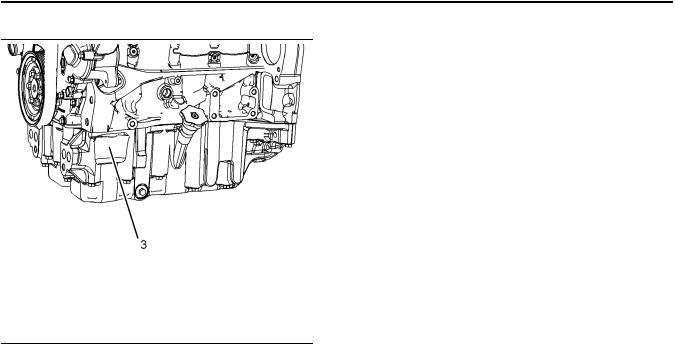
26 |
SEBU8726 |
Product Identification Information
Plate Locations and Film Locations
Illustration 22 |
g02826736 |
Typical example
On a stressed cylinder block the serial number is located in position (3).
The engine serial number is stamped on the emissions plate.
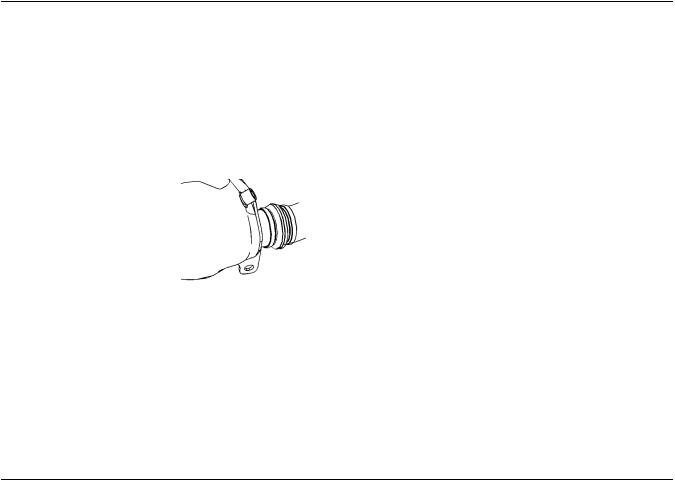
SEBU8726 |
27 |
Product Identification Information
Plate Locations and Film Locations
i05328112
Plate Locations and Film Locations
(Aftertreatment)
Wall Flow Diesel Particulate Filter (DPF)
Illustration 23 |
g02475495 |
Typical example
The serial number for identifying the aftertreatment will be in two locations. On the DPF in position (1) and in position (2). On the end cover of the inlet to the DPF.

28 |
SEBU8726 |
Product Identification Information
Plate Locations and Film Locations
Illustration 24 |
g02723697 |
(1) Serial numbers on main body |
(2) Serial numbers on inlet end cover |
Ensure that all numbers on the aftertreatment are recorded.
Your Perkins distributor or your dealer will require all the numbers in order to identify the components for your aftertreatment.
i05328174
Plate Locations and Film Locations
(Aftertreatment)
Through-Flow Diesel Particulate
Filter (DPF)
A serial number label for identifying the through-flow
DPF will be located on the main body of the DPF.
i04460799
Emissions Certification Film
The emission label will be installed on the left side of the non-stressed cylinder block.
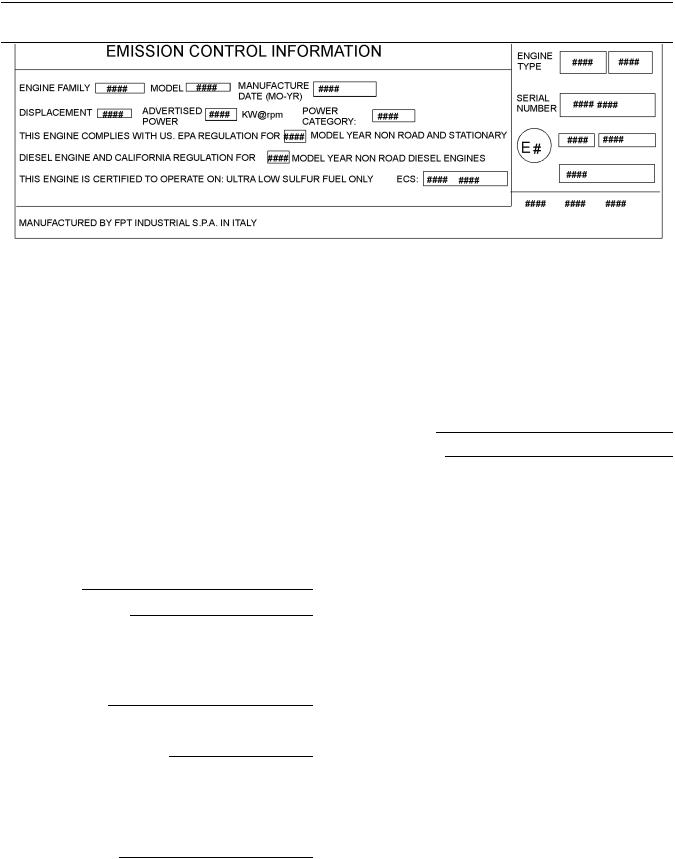
SEBU8726 |
29 |
Product Identification Information
Reference Information
Illustration 25 |
g02646428 |
Typical example |
|
i05324886 Engine Aftertreatment System
Reference Information |
Part Number |
|
Serial Number |
Information for the following items may be needed to |
|
order parts. Locate the information for your engine. |
|
Record the information in the appropriate space. |
|
Make a copy of this list for a record. Keep the |
|
information for future reference. |
|
Record for Reference
Engine Model
Engine Serial Number
Engine Low Idle Revolutions Per Minute (RPM)
Engine Full Load RPM
Primary Fuel Filter
Secondary Fuel Filter Element
Lubrication Oil Filter Element
Auxiliary Oil Filter Element
Total Lubrication System Capacity
Total Cooling System Capacity
Air Cleaner Element
Drive Belt
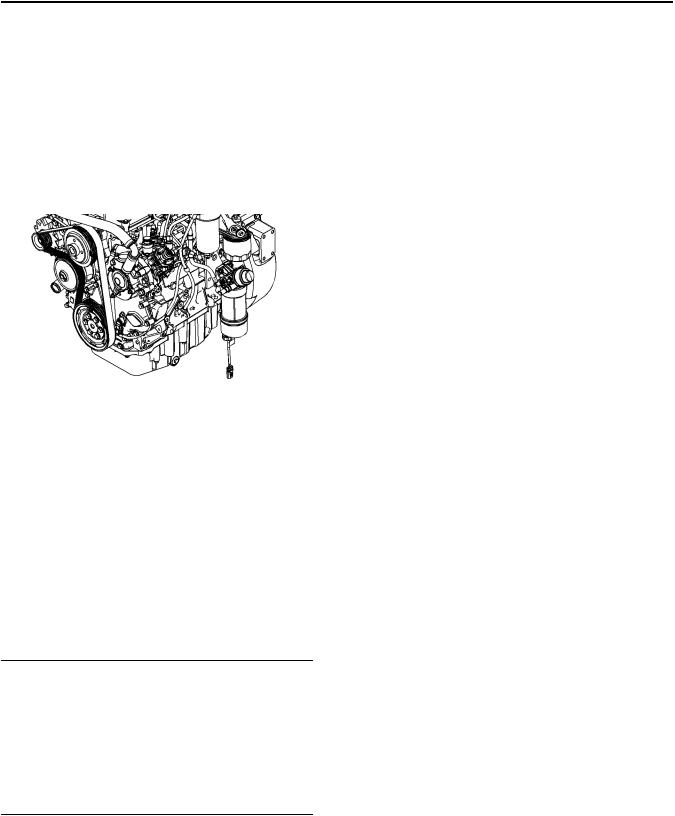
30
Operation Section
Product Lifting
Operation Section
Lifting and Storage
i04315227
Product Lifting
Illustration 26 |
g02475658 |
Typical example
NOTICE
Never bend the eyebolts and the brackets. Only load the eyebolts and the brackets under tension. Remember that the capacity of an eyebolt is less as the angle between the supporting members and the object becomes less than 90 degrees.
When it is necessary to remove a component at an angle, only use a link bracket that is properly rated for the weight.
Use a hoist to remove heavy components. Use an adjustable lifting beam to lift the engine. All supporting members (chains and cables) should be parallel to each other. The chains and cables should be perpendicular to the top of the object that is being lifted.
SEBU8726
Some removals require lifting the fixtures in order to obtain correct balance and safety.
To remove the engine ONLY, use the lifting eyes that are on the engine.
Lifting eyes are designed and installed for specific engine arrangements. Alterations to the lifting eyes and/or the engine make the lifting eyes and the lifting
fixtures obsolete. If alterations are made, ensure that correct lifting devices are provided. Consult your
Perkins dealer or your Perkins distributor for information regarding fixtures for correct engine lifting.
Note: The engine is equipped with three lifting eyes. All the lifting eyes must be used in order to lift the engine.
i04084189
Product Storage
(Engine and Aftertreatment)
Perkins are not responsible for damage which may occur when an engine is in storage after a period in service.
Your Perkins dealer or your Perkins distributor can assist in preparing the engine for extended storage periods.
Condition for Storage
The engine must be stored in a water proof building. The building must be kept at a constant temperature. Engines that are filled with Perkins ELC will have coolant protection to an ambient temperature of −36° C (−32.8° F). The engine must not be subjected to extreme variations in temperature and humidity.
Storage Period
An engine can be stored for up to 6 months provided all the recommendation are adhered to.
Storage Procedure
Keep a record of the procedure that has been completed on the engine.
Note: Do not store an engine that has biodiesel in the fuel system.
1.Ensure that the engine is clean and dry.
a.If the engine has been operated using biodiesel, the system must be drained and new filters installed. The fuel tank will require flushing.
